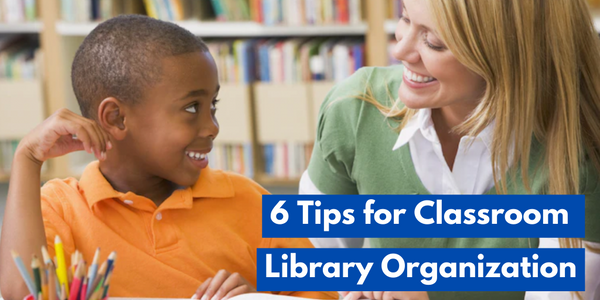Editor's Note: This blog was previously published, we're re-sharing it today as teachers begin their fall semester.
By Beth Richards, Literacy Interventionist, Reading Recovery Teacher, Guest Blogger
As teachers, we live for those moments when our students are excited to read, especially those who have previously been reluctant or striving readers. But what do you do when a child’s excitement is focused around a leveled book that you know is out of reach? This post will give you some strategies for helping students access more complex texts.
Research demonstrates the importance that emotion and motivation can play in engaging young readers. Lyons (2003) discusses the factors involved with the amygdala storing positive literacy experiences in the brain and reminds us that “ the brain always gives priority to emotions ” (66). Motivation, whether extrinsic or intrinsic, influence how much and how often children read. (Miller and Mercedes 1997; Wigfield and Guthrie 1997). But motivation and emotions on the student’s part cannot be the only factors coming into play. Motivation and emotion will make them want to work harder to read it successfully, but they will still need scaffolding to bring it to fruition.
1. Use a variety of texts at different levels.
When my son was six, he was obsessed with the Titanic. As you can imagine, finding appropriately leveled texts for him on that topic was nearly impossible, but that didn’t stop him from lugging home book after book on the topic. One evening, we sat on the floor surrounded by all the Titanic books we had, and I picked out three that I felt were at his reading level. I guided him through the easiest text first, providing support when necessary, and letting him talk through all the new learning taking place.
 After reading, we had quite a discussion, as he asked questions and tried to assemble it all into that new Titanic file folder in his brain. That conversation and learning with an accessible text were crucial. Since he now had some familiarity with the topic, vocabulary, names, and experiences, he was able to use that background knowledge to help him read the next text, leveled higher than the first. He was freed up for new problem-solving after laying his foundation of learning through the first text.
After reading, we had quite a discussion, as he asked questions and tried to assemble it all into that new Titanic file folder in his brain. That conversation and learning with an accessible text were crucial. Since he now had some familiarity with the topic, vocabulary, names, and experiences, he was able to use that background knowledge to help him read the next text, leveled higher than the first. He was freed up for new problem-solving after laying his foundation of learning through the first text.
2. Use Text Sets
 I love the idea of text sets.
New learning is easily acquired when situated in children's prior knowledge.
But through my work with EL students, my understanding of how and why to use a text set has changed. I’m no longer married to using text sets to help support the teaching of a particular topic, with all the texts at the same instructional level for the students. The books should increase in complexity and can even be based around a new theme, such as what activities friends do together (
Friends Together!
&
Playing Together
), making friends (
Friends Are Fun
), or social-emotional lessons (
Are You a Bully?
). This helps students relate to the characters, make real-world connections to the text, make predictions, and anticipate possible language structures.
In addition, kids will have opportunities to make text-to-text connections as well as apply the problem-solving activities they used in the first text to navigate the others, which will make those out of reach texts accessible.
I love the idea of text sets.
New learning is easily acquired when situated in children's prior knowledge.
But through my work with EL students, my understanding of how and why to use a text set has changed. I’m no longer married to using text sets to help support the teaching of a particular topic, with all the texts at the same instructional level for the students. The books should increase in complexity and can even be based around a new theme, such as what activities friends do together (
Friends Together!
&
Playing Together
), making friends (
Friends Are Fun
), or social-emotional lessons (
Are You a Bully?
). This helps students relate to the characters, make real-world connections to the text, make predictions, and anticipate possible language structures.
In addition, kids will have opportunities to make text-to-text connections as well as apply the problem-solving activities they used in the first text to navigate the others, which will make those out of reach texts accessible.
3. Share the Task
How many times have you seen students clamber to your classroom library, frantically searching for that book you finished reading to them earlier in the day? It’s because you have shared the task, carried the burden of the text’s complexities, and made the text feel manageable for students. The benefits of reading aloud to students are often forgotten once students are able to read independently; sometimes, we may withhold a read aloud or reserve it only for a mini-lesson or those last few minutes of the day before the bell rings.
However, reading aloud can be the springboard for students becoming more willing to take risks with their reading. In the upper grades, you can read the first chapter to students as you prepare them to continue the text independently. In the younger grades, during a guided reading group with a more challenging text, read the first few pages out loud. This will ensure that you help lay the groundwork, build a solid understanding, and give them the confidence they need to finish the rest of the book on their own.
4. Hook Students on a Series of Books
How many of us can honestly say we’ve never binge-watched a television show? We want our students to also be emotionally invested in characters and their situations, chomping at the bit to get to a brand new adventure in the series in order to find out what happens next as readers. Your role in this is important. Read the first book in a series to them, give powerful book-talks, and encourage your students to give reading recommendations to others in order to get them going.
5. Adjust Your Scaffolding
The amount of support you need to give striving readers varies from text to text. In order to help your students be successful with a text that is more complex than what they normally take on, you can provide additional (or perhaps different) supports. These may include chiming in with the reader to help them navigate trickier language structures, previewing and utilizing text features prior to reading, or making the following comments as they turn the page to help them maintain meaning and anticipate:
- They’ve been talking about their plan to help Grandma; I wonder how they’re going to get started.
- So far, you’ve learned that baby frogs are called tadpoles; I bet we’ll learn how those tadpoles grow and change into frogs.
Fostering a love of reading in students is our goal as teachers. So when a motivated child approaches you with a tricky text, instead of saying, “ That one seems too hard for you ,” use the above strategies to help create a positive reading experience. Be sure to stay tuned for additional blog posts about creating a supportive literacy environment for your students!
~~~
 Beth has been teaching for seventeen years. She has taught kindergarten, third, and fourth grades in Wisconsin. For the last six years, she has been a literacy interventionist and Reading Recovery teacher and loves spending her days helping her students develop and share her love of reading.
Beth has been teaching for seventeen years. She has taught kindergarten, third, and fourth grades in Wisconsin. For the last six years, she has been a literacy interventionist and Reading Recovery teacher and loves spending her days helping her students develop and share her love of reading.
~~~



![5 Strategies to Increase Reading Time and Complexity [Grades K–2]](http://www.hameraypublishing.com/cdn/shop/articles/Main_image_Young_boy_reading_in_library_Shutterstock_1183203157_Ann_in_the_UK_2f1b716c-ebcb-4f18-ac17-7c9420998272_1024x1024.jpg?v=1689962013)



